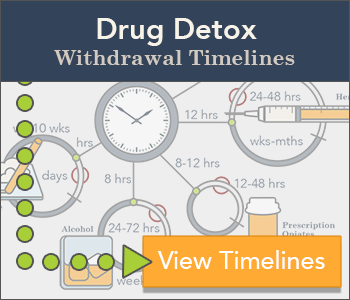Guide to Drugs on Social Media
Social media has completely rewritten the way the world communicates, with human contact and connections being boiled down to algorithms and jargon that are broadcast from a device that fits into the palm of our hands. For all the good of online platforms, concerns have arisen about what it exposes its users to. Drugs on social media is a two-way street – one of temptation and one of recovery.
The Double Whammy
Bloomberg says that the intersection between social media and drug use is “a double whammy,” where consumption of illegal substances is normalized and glamorized in high-definition pictures and videos. Drug use isn’t something that is limited to celebrities and strangers; now, friends (and even family members) can share a picture of a row of shot glasses, a joint of marijuana, or even harder and more dangerous drugs with hundreds of contacts, all at the click of a button. The instantaneousness of the connection also allows users and their dealers to stay in touch through instant messaging programs that are often part of social medial platforms.
To that end, a 2011 survey conducted by the National Center on Addiction and Substance Abuse at Columbia University found that teenagers who regularly use popular social media outlets (such as Facebook) were more likely to drink, use drugs, and buy tobacco than adolescents who either did not use social media or used it less.
The survey asked 2,000 adolescents about their drug use and social media habits, and 70 percent said that they use social media on any given day. Researchers found that, compared to nonusers or light users of social media, this group was:
- Five times more likely to buy cigarettes
- Three times more likely to drink
- Twice as likely to use marijuana

What these people tend to see on social media are pictures and videos of people they know (or people they would like to know) using drugs. But the founder and chairman of the National Center on Addiction and Substance Abuse cautions against making a simplistic connection between social media and drug use. Social media doesn’t cause drug use, Joseph Califano said, but there is the fear that services like Facebook, reddit, or 4chan will create “a new form of peer pressure” that will compel vulnerable teenagers into engaging in drug use.
Perfection Pressure
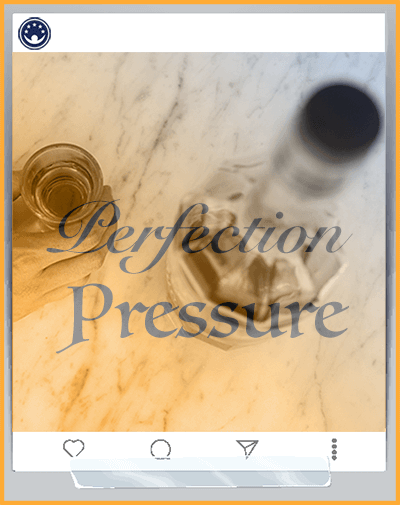
Teenagers themselves feel that this will be a problem, with a 16-year-old high school junior telling the Chicago Tribune that the Internet convinces users that “everyone else is having more fun than you.” The New York Times calls this “the pressure of perfection.” Social media allows its users to present a meticulously curated version of their lives, one that eschews honesty for social status. For some impressionable people, seeing their friends and family out having fun (in the form of Facebook posts or tweets) can tempt them into making a risky choice; for others, it can depress them enough into seeking solace with drugs and alcohol. The center’s survey found that many teenagers (some as young as 14) have seen images or videos of other adolescents who have passed out after drinking or doing drugs. A psychologist at the University of Washington conducted an experiment of her own, which suggested that people who saw visual representations of alcohol consumption “said they were more willing to get drink in the future,” and had favorable impressions of the type of people who got drunk and broadcast it on social media. And those types of people don’t have to be friends; it could be friends of friends or complete strangers. The images might not be limited to weekends and vacations; they maybe shared any day of the week, any time of day, constantly reinforcing the idea that excessive alcohol consumption is normal and desirable. Adding to the message are captions and status messages that glamorize the activities depicted in the videos and pictures.
Social Media vs. Real Life
A spokesman for Facebook told the Tribune that the company removes any content that promotes illegal drug use or underage drinking based on whether users flag the content as objectionable. In covering its bases, Facebook also pointed out that research at the Center on Juvenile and Criminal Justice in San Francisco has not yet been able to control for other factors, such as parents’ use of drugs or alcohol, family history of mental illness or addiction, environmental stressors, etc., that could have a bigger role to play in teenage substance abuse than social media. Mike Males, a researcher at the San Francisco center, acknowledges that social media has a role to play in encouraging drug use, but “real life” may make that role pale in comparison. Exposure to drug or alcohol use in offline life can have a much bigger impact; and according to Males, the study by the National Center on Addiction and Substance Abuse doesn’t address that dynamic.
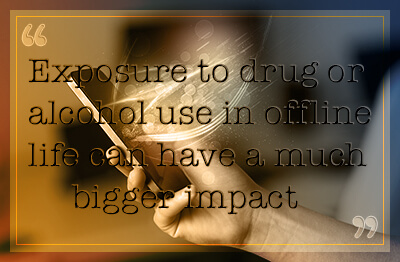
Easier than Buying Coffee
Mainstream social media networks have very explicit rules on the kind of content they permit to be shared. Facebook, for example, states that its 1.7 billion users are not permitted to purchase, sell, or trade drugs, and that users who break this rule will be subject to account termination and/or legal liabilities under applicable laws. Unsurprisingly, this does not deter people who want to sell drugs, and it does not deter the people who want to buy the drugs. Facebook is, by far, the most popular social network that exists, and finding drugs on the platform is “easier than buying a cup of coffee,” according to the McAfee Institute. In Colorado, where the sale of recreational marijuana is limited to adults, a hidden Facebook group acted as a marketplace for high schoolers to buy and sell cannabis as well as synthetic marijuana, prescription drugs, methamphetamines, MDMA, and LSD. The group had 900 members in total, and 171 of them were students from 55 high schools and middle schools across a single metro area. Police were more interested in using the experience as a learning opportunity for parents, children, and educators about how an otherwise benign (and even beneficial) service like Facebook could be usurped by people looking to expose high schoolers to the drug trade. Nonetheless, police arrested one man on charges of distributing controlled substances, and Facebook closed down the group when investigators contacted the company.
Social Drug Dealing
A similar situation took place in Adelaide, Australia, where a local news organization discovered the existence of another “hidden” Facebook group, where the privacy settings are such that only the group’s members are aware of its existence, and joining the group happens by invitation only. The so-called “Adelaide street pharmacists” group had over 200 members, which Facebook shut down when alerted by the news organization. A criminologist at the University of Adelaide Law School explained that the group and others like it are examples of “social drug dealing,” where social media platforms (like Facebook) are becoming increasingly used by criminals of all colors, allowing drug dealers to hide in plain sight. “The Internet is probably the primary mechanism for drug dealers” because using social media and smartphones to conduct business is far quicker and more efficient than methods of the past. The same privacy settings that are meant to protect users’ confidential information are also used by drug dealers to cover their tracks and render themselves invisible among the millions of legitimate Facebook groups and pages. Criminals always exploit any form of technology and innovation they can, and social media is no exception. And the ubiquity of platforms like Facebook blur the line between the online world and real life, to the point where placing an “order” through a hidden Facebook group can result in drugs being delivered to a user’s front door.
Pharmacies
Pharmacies is a code word that is often used by drug smugglers to create seemingly legitimate groups to sell their products. The International Narcotics Control Board reported that “illegal Internet pharmacies” use social media, as well as the perception of authority and validity, to unlawfully market prescription drugs to people. The president of the board explained that such organizations “have started to use social media to publicize their websites.” The platforms include YouTube and Facebook, where young (or otherwise impressionable) people are lured into chat rooms with “doctors” for “consultations” that always culminate with the sale of drugs. Needless to say, the “doctors” are not really doctors, and the “consultations” are meaningless conversations that serve only to heighten the victims’ fears to facilitate the sale. People trust social media more than they do advertising, and being told by a “doctor” in a Facebook chat that they need pills and tablets for whatever ailment they have adds a veneer of legitimacy to the process. Victims tend to be poor, poorly educated, unemployed, and easily deceived by someone telling them what they want to hear, on a platform that all their friends and family use via a medium that they can hold in their hand and put in their pockets.
The Digital Drug Trade
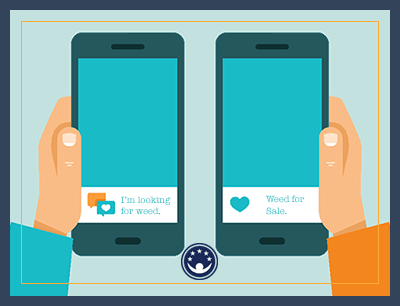
Facebook may be the name that comes to mind when the term social media is used, but there are literally hundreds (if not thousands) of platforms that allow users of all walks of life to connect, and drug dealers are attuned to all of them. For example, Grindr, a social networking mobile app designed for gay and bisexual men to find romantic and/or sexual partners in a specific geographic area, has become a gateway to attaining drugs. In the same way that Facebook’s privacy settings are used by dealers to cover their tracks, Grindr (and other dating apps) has privacy features that give both parties anonymity for their own safety. While this is a useful function when the apps are used as intended (to meet potential romantic or sexual partners), it takes on a new dynamic when the anonymity is used by drug dealers and their potential customers.
Grindr is a popular platform on which to find and sell methamphetamine (The Fix writes of how the use of that particular drug has reached epidemic levels in the gay community, and Grindr markets itself as “the world’s largest gay social network app.”) but as many as 73 percent of people who report purchasing illegal drugs did so over social media apps. The instantaneousness of finding drug dealers on any such app is staggering. The Coalition Against Drug Abuse found 50 dealer accounts on the Facebook-owned picture-sharing social media app Instagram (300 million active monthly users) in a single day by searching for terms as simple as “weed 4 sale.” In a matter of a few minutes, the coalition had downloaded the app, created an account, found a dealer, messaged the dealer, and received a response. The drugs available ranged from marijuana to prescription painkillers and MDMA. Requests are sent via direct messaging or leaving comments on dealers’ pagers, and payments are made electronically and immediately through the use of peer-to-peer payment services like PayPal.
“The next wave of freelance narcotics is online,” warns Kindland, and with millions of people having a smartphone in their hand, the marketplace is everywhere.
The Digital Underground and 50 Million Users
Complex calls this the “digital underground,” where the possibilities of buying drugs are “limitless.” One person speaking to the Complex explained how he struggled to find ketamine, his drug of choice, in real life, but within minutes of using Grindr, he made contact with a dealer who was selling. All it takes is for a smartphone app to be social and location-based for a dealer to find a customer. Dealers often have multiple accounts, both as a safeguard against the inevitable closure of one account and as a way of marketing themselves to more users. “The process,” says The Guardian, “is simple.” All social media services and companies have explicit rules about posting, sharing, or selling controlled substances on their platforms; dealers, in return, label their products as “research,” “experimental,” and “not intended for human consumption,” giving themselves a thin layer of plausible deniability (and enough time to disappear) when their accounts are flagged. Some social media apps are specifically designed for anonymous communication. Journalists might use them to talk with sources, regular people might like their conversations not potentially being snooped on by government agencies, and dealers and customers find the layers of security to their mutual benefit. No matter the encryption, digital dealings always leave a trail, and investigators are more than capable of sending a dealer to jail for a very long time for deals conducted months or years prior. Grindr’s market is exclusively gay and bisexual men, but the dating app landscape is ruled by Tinder. With nearly 50 million users by late 2014, the company is worth an estimated$1.35 billion, and this kind of a market is irresistible to drug dealers whose profiles exist side by side with those of legitimate people looking for a connection. While most users have profile pictures that present themselves as viable partners, dealers simply have images of their products as well as symbols (emojis) that, at a glance, convey the quality, purity, amount, and cost of the product, which ranges from weed to Ecstasy.
Drugs on the Dark Web
For the vastness of the virtual real estate that companies like Facebook, Instagram, or Tinder command, as much as 96 percent of the Internet operates beyond the reach of normal search engine results. This region of cyberspace is known as the deep web. While it has many useful and beneficial applications (like online banking), a small subsection of this deep web is almost entirely devoted to criminal activity, including the buying and selling of drugs. This subsection is known as the dark web, where users can exchange stolen credit card information, buy firearms without background checks, and even arrange for the services of professional hitmen. Users can also find any number and kind of drugs, available for sale in a format similar to browsing Amazon or eBay. Vendors respond to private messages about the quality and quantity of the product, and users leave feedback to describe their transaction experience. The kind of transactions that take place on the dark web are complex, criminal activities. The operators of these black markets present their services as a choice of “freedom over tyranny.” The slogan was employed by Silk Road, which was the largest single website on the dark web that sold drugs. Two years after it went online in 2011, it had a million users. In 2013, when federal agents from a number of agencies shut down its servers and arrested its 29-year-old founder, Silk Road had seen nearly $1.2 billion in encrypted transactions, and its founder (now serving a life sentence without parole) had made $80 million. The victory over Silk Road was short-lived. Within months of the site going down, dozens of copycats sprung up to replace it, with servers located all over the world. Even as local and international police collaborated to fight back, the plague continued to spread. Not withstanding the fall of the original Silk Road and the message sent out by the lifetime incarceration of its founder, “buying drugs online remains easy,” says US News & World Report. The operators of dark net marketplaces are intelligent, cunning, and very adept at dodging law enforcement, playing a long game of cat-and-mouse that they don’t mind occasionally losing because they know there will always be a demand for the products they peddle and that business can be conducted over smartphones, which 68 percent of Americans have. There is a world of difference between having a Facebook account and accessing the dark web, but both are astonishingly easy to use. The special browser to get on the deep web is free, and it can be downloaded onto mobile devices from popular application stores.
Find Substance Abuse Treatment Near Me
The Protective Effort
Social media itself may be on its way to being a bigger temptation for teenagers than drug or alcohol abuse. A study out of Michigan University found that in 2015, teens were using alcohol and drugs at the lowest numbers since 1990s. Researchers felt that part of this decline was due to adolescents socializing less because they spend so much time on their mobile devices. The director of the National Institute on Drug Abuse suggested that engaging with friends via social media keeps kids at home and away from face-to-face peer pressure. Dr. Nora Volkow referred to this as a “protective effort,” effectively depriving teenagers (and other people who might be otherwise compelled to use drugs or alcohol) of the time to engage in that behavior. The Monitoring the Future study found that there was a 1.1 percent drop in the number of 8th graders who reported using marijuana between 2015and 2016. The rate of drinking is the lowest it has ever been since Michigan University started tracking, more than 40years ago; figures from 2015 show a drop of over 37 percent.
Taking the Fight to Facebook
Public health and anti-drug advocates are making the most out of the exorbitant amount of time adolescents and young adults spend on their social media accounts. The director of health at the Oneida County Health Department in New York said that the message of the harm and danger of drug abuse is getting through, via social media campaigns that emphasize the numbers and reality of drug addiction. Such methods increase awareness and education in a medium and format that is ubiquitous. The Centers for Disease Control has also gotten on board. In April 2015, the organization launched an online initiative, whereby people whose lives were damaged by prescription painkiller abuse were invited to share their stories as warning signs for others who may have been tempted by what they hear and see on the same social media platforms.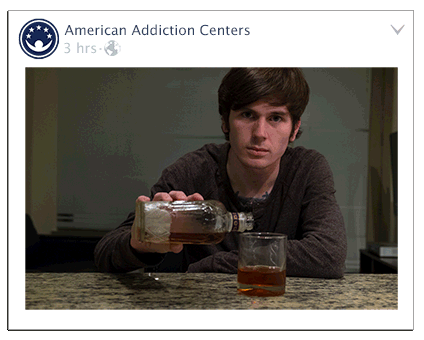
Sometimes, it’s more than words. An advertising agency in Israel created a Facebook profile that used the social network’s “Timeline” feature to juxtapose a man’s life falling apart while on drugs to him enjoying life without his addiction. Ironically, the profile is in violation of Facebook’s terms regarding marketing and fake profiles, but ZDNet wondered if this kind of campaign will nonetheless make an impact on the kind of people who would be swayed by what they see when they pull out their phones to check their accounts (as they do multiple times during the day). Police departments are also using social media platforms to announce successful drug busts and sting operations, which act as deterrents to potential customers.
The Stoner Sloth Lesson
But social media is a fickle landscape, and not all campaigns end well. An anti-marijuana promotion launched by Australia’s New South Wales government was widely ridiculed for its unintentionally hilarious caricature of a “stoner” as a lazy, uncommunicative sloth. New South Wales defended the campaign as an “[encouragement] of positive behaviors in young people,” to motivate them to give up marijuana before bad habits take form. The short video clips of a literal sloth being too stoned to function are “designed to appeal to, and be ‘shareable’ among teenagers,” who are not only the most vulnerable to cannabis use but also use social media the most out of any age demographic.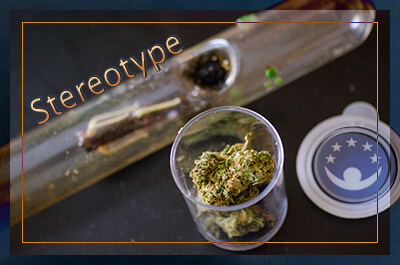
“We know that younger audiences respond more to campaigns highlighting the short-term consequences of their actions,” said the New South Wales government, but the country’s own National Cannabis Prevention and Information Centre distanced itself from the promotion. “Teenagers are intelligent and have access to a lot of information,” said the center, and the “Stoner Sloth” campaign did not give its audience the appropriate respect and credit, instead relying on hyperbole and stereotypes.
The Social Media Drug
Social media can be as much a blessing as it can be a curse, and researchers are wondering if the same “protective effort” that Dr. Nora Volkow of the National Institute on Drug Abuse spoke of may be a double-edged sword. Rolling Stone points out that one reason for the dramatic change is that social media behavior can itself be addicting. Teenagers as young as 13 check their Facebook, Twitter, Instagram, and Pinterest profiles upwards of hundreds of times every day, and a study out of the Psychological Science journal examined “adolescents’ behavioral and neural responses to […] quantifiable forms of social endorsement,” such as “likes,” retweets, shares, and other kinds of positive feedback. Researchers found that receiving many such endorsements“ was associated with greater activity in neural regions implicated in reward processing,” the same mechanism by which substance abuse causes addiction in users’ brains. Drug use changes the human brain over time, and so does the Internet.
Disordered Social Media Use and Risk Factors for Drug Use
Coming to rely on social media for reward and pleasure brings its own downsides, most of all that a fixation on cultivating identities and validation on online platforms has been connected with depression and insomnia, both of which can lead to drug abuse on their own. Psychologists at the University of Albany sampled 253 undergraduate students about how they used social media and the Internet, and how they regulated their emotions and alcohol consumption. Ten percent of the students exhibited behaviors that resembled substance addiction in how they used social media platforms; those who had “disordered social media use” had a greater likelihood of struggling to control their emotions (i.e., having poor impulse control) and drinking problematically.
The psychologist who led the study explained that the constant (and unpredictable) stream of content, media, and validation“ established habitual behaviors,” a process that increases the vulnerability to different forms of addiction. In the same way that substance abuse has many different risk factors (e.g., family history, mental health, lifestyle, environment, etc.), “disordered social media use” could be one such risk factor. With drug dealers taking to Facebook and Tinder to market their drugs, the combination is a dangerous one.
